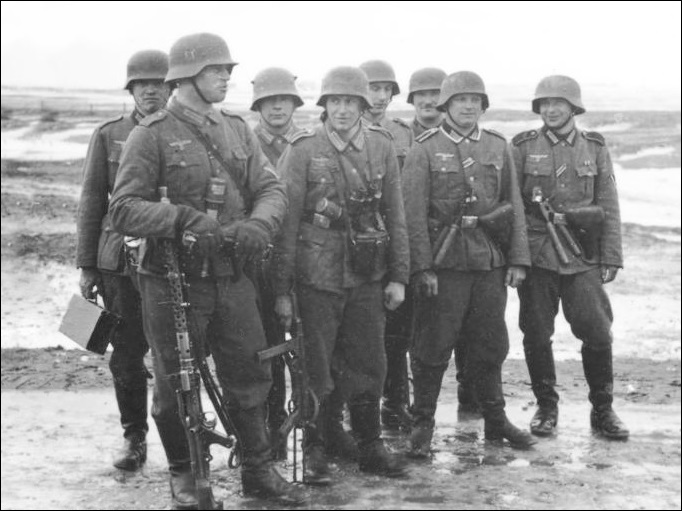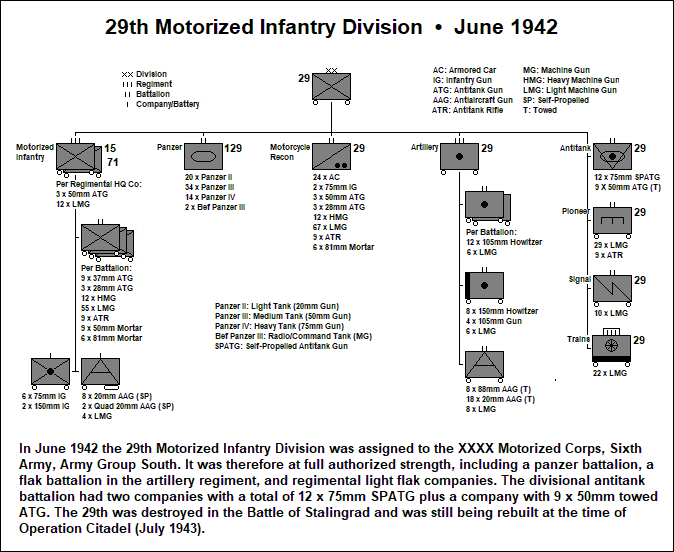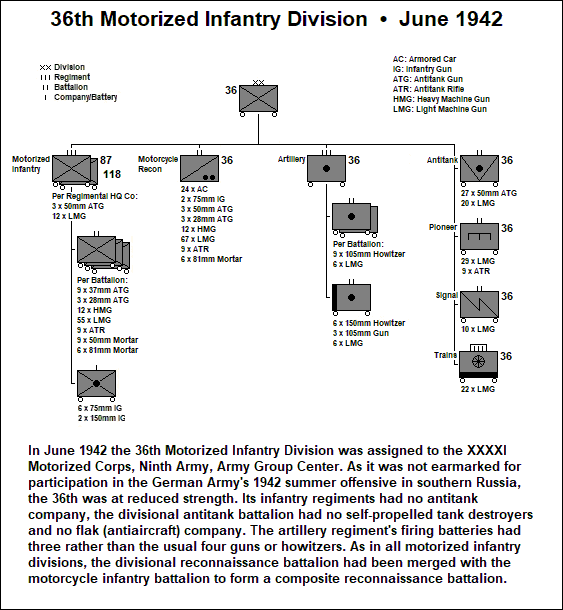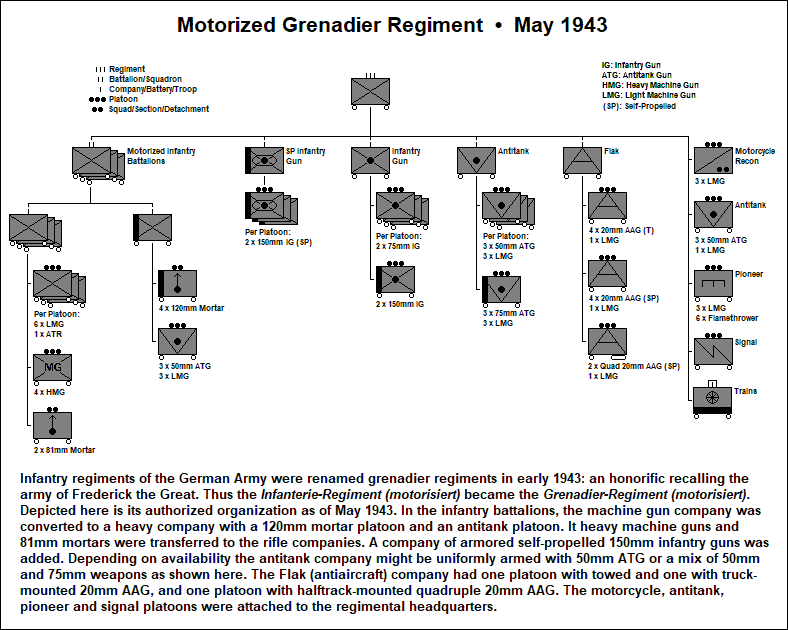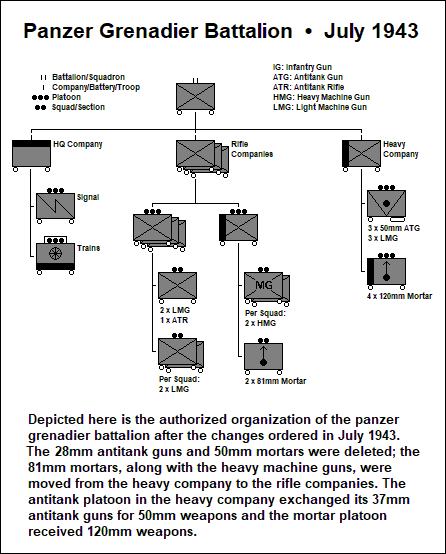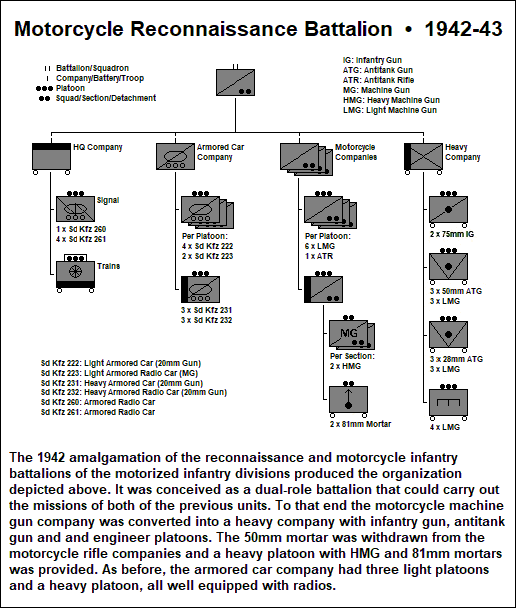NOTE ON
NOMENCLATURE
In July 1942 the infantry regiments
of the motorized infantry divisions were redesignated as
motorized grenadier regiments. Then in June 1943 the
motorized infantry divisions and their component grenadier
regiments were redesignated as panzer grenadier divisions
and regiments. Neither change, which in the latter case took
several months to implement, affected their actual
organization. To avoid
confusion, the term motorized infantry
will be used for 1942 and panzer grenadier
for 1943.
● ● ●
By the spring of 1942 the German
Army’s motorized infantry divisions, badly depleted in the
previous winter’s fighting, had been rebuilt in line with
the new table of organization promulgated in November 1941. It proved
impossible, however, to bring them all up to full strength.
Only those earmarked for Army Group South’s 1942 summer
offensive had all or most of their authorized manpower and
equipment. For the rest, a reduced establishment was
specified. Their artillery regiments had three instead of
four howitzers and guns per battery, and they lacked the
panzer battalion, self-propelled antitank guns (SPATG or
tank destroyers), flak
(antiaircraft) battalions and regimental flak companies that
the motorized infantry divisions in Army Group South
received. The organizational diagrams appended to this
article depict the 29th Motorized Infantry Division (full
establishment) and the 36th Motorized Infantry Division
(reduced establishment) as of June 1942. In both division
types there were occasional minor deviations from the
standard organizations shown.
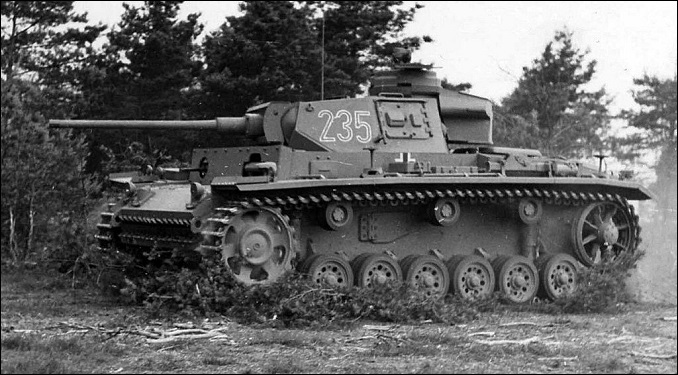
The Panzer III was
the principal tank of the separate panzer battalions
of the full-strength motorized infantry divisions
assigned to Army Group South in mid-1942. This
example is a Panzer IIIL (50mm L/60 gun), fitted
with extra "stand-off" armored plating. (Bundesarchiv)
The panzer battalions added to the
full-establishment divisions were taken from panzer
divisions on the inactive fronts and were renumbered based
on their new divisional assignment, e.g. Panzer-Abteilung
129 of the 29. Infantrie-Division (motorisiert).
Mostly they had two light companies each with 5 x Panzer II
(20mm gun) and 17 x Panzer III (50mm gun), and one medium
company with 5 x Panzer II and 10 x Panzer IV (75mm gun). An
additional 5 x Panzer II and 1 x Panzer III were in the
battalion headquarters company, along with 2 x Bef Panzer
III radio/command tanks. The medium company should have had
a third platoon with four more tanks, but Panzer IVs were in
short supply so it was provisionally deleted. Nor were
sufficient Panzer IIs available, so that many platoons had
four or even three instead of the authorized five tanks.
In the motorized infantry
regiments, the infantry gun (IG) company was unchanged (6 x
75mm and 2 x 150mm IG) but the antitank (AT) company was
deleted. Instead, an AT platoon with 3 x 37mm antitank guns
(ATG) was added to the infantry battalion machine gun
companies (redesignated as heavy companies) for a regimental
total of nine. An additional AT platoon (3 x 50mm ATG) was
added to the regimental headquarters company. Each rifle
company received 1 x 28mm ATG, for a regimental total of
nine. The infantry regiments of the full-establishment
divisions also received an SP light flak company with either
12 x 20mm or 8 x 20mm and 2 x 20mm (quad) antiaircraft guns
(AAG).
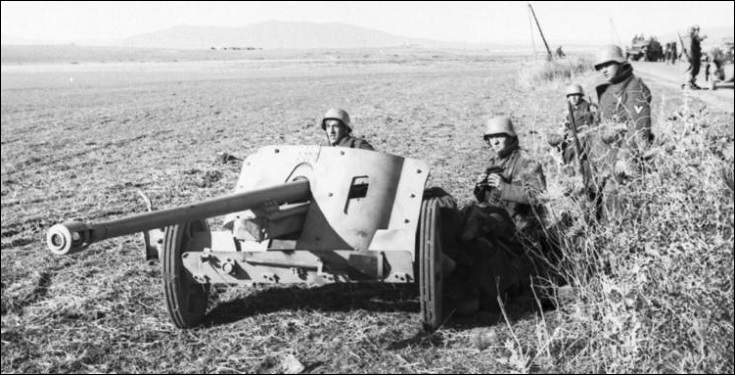
The halftrack-towed
50mm PAK 38 was the principal antitank gun of the
1942-43 motorized infantry division. Though an
improvement over the 37mm PAK 36 it was marginally
effective at best against the Red Army's medium and
heavy tanks (Bundesarchiv)
For all divisions, the motorcycle
infantry battalion and the motorized reconnaissance
battalion were merged to form a motorcycle reconnaissance
battalion with one armored car company, three motorcycle
infantry companies and a heavy company. It was planned
eventually to replace the motorcycles with variants of the SPW 250 light armored halftrack and the Volkswagen
Kübelwagen light field car, and these were just beginning to
enter service in the spring of 1942—though most went to the
armored reconnaissance battalions of the panzer divisions.
The divisional
Panzerjäger
(AT) battalions varied in composition. Those of the
full-establishment divisions had two companies with 6 x 75mm
SPATG each and one company with 9 x 50mm towed ATG; those of
the reduced establishment divisions mostly had three
companies, each with 9 x 50mm towed ATG. In two of the
full-establishment divisions the Panzerjäger
battalion included a light flak company with 12 x 20mm AAG.
In one battalion these AAG were SP; in the other they were
towed.
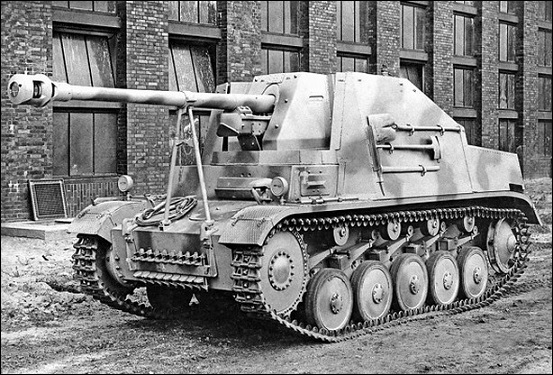
The Marder II
tank destroyer. It was based on the Panzer IIF
tank chassis and mounted the 75mm L/40
gun in an open-topped fighting compartment. In
this photo the gun barrel is fixed in the travel
position. (Military Images)
Most of the artillery regiments had
two light battalions with 105mm howitzers, and one heavy
battalion with two batteries of 150mm howitzers and one of
105mm guns. In a few divisions, however, all three batteries
of the heavy battalion had 150mm howitzers. The artillery
regiments of the reduced-establishment divisions often had
older weapons and at least one, the 25th, had captured Czech
105mm howitzers. The artillery regiments of the
full-establishment divisions included a flak battalion with
8 x 88mm AAG and 18 x 20mm AAG, all towed.
The 1942 campaign ended in disaster
with the destruction of the Sixth Army at Stalingrad. All of
the motorized infantry divisions in Army Group South were
badly battered and three were lost. On 1 March 1943 Hitler
appointed Colonel-General Heinz Guderian as
Generalinspekteur der Panzertruppen (Inspector General
of Armored Troops) with wide-ranging authority, and it was
under his direction that the panzer grenadier divisions, as
they came to be called, were rebuilt. The organizational
template was similar to that of the 1942 division but the
panzer battalions were for the most part converted to
assault gun battalions equipped with the Sturmgeschütz III,
an armored fighting vehicle based on the chassis of the
Panzer III. The StuG III carried a 75mm gun in an armored
casement with limited traverse, and in addition to its
original infantry support role it proved effective as a tank
destroyer.
In the panzer grenadier regiments
the heavy company reverted to its earlier status as a
machine gun company with 12 x heavy machine guns (HMG) and 6
x 81mm mortars, the ATG platoon being deleted. The ATG
platoon in the regimental headquarters company was also
deleted. Instead a regimental AT company with 12 x 50mm
towed ATG was provided. The regimental IG company remained
unchanged, though it was planned eventually to exchange the
towed guns for SP models.
It was also planned to convert the
motorcycle reconnaissance battalion into a
Panzer-Aufklärungs-Abteilung
(armored reconnaissance
battalion) equipped with light armored halftracks in place
of wheeled armored cars and motorcycles. Here, however, the
panzer divisions received priority and by the summer of 1943
only three of the nine panzer grenadier divisions had an
armored reconnaissance battalion.
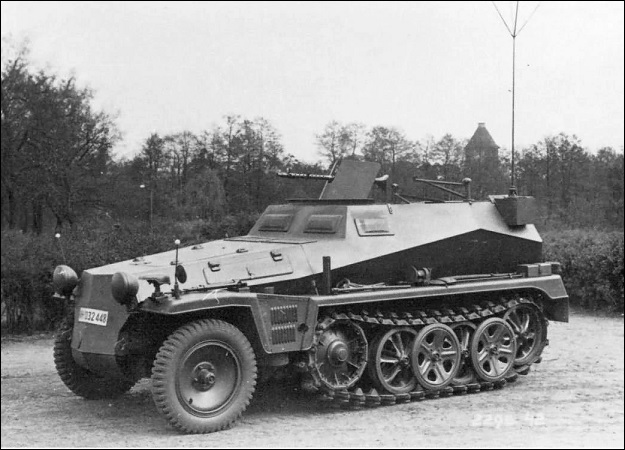
In 1942 the SPW 250/1 light
armored halftrack was selected to replace
most motorcycles in the reconnaissance
battalions of the panzer grenadier
divisions. It had a crew of two and could
carry four troops. The additional machine
gun mount was for the recon section's LMG. (Bundesarchiv)
It
was much the same story with the divisional
Panzerjäger battalion.
The desired standard was a battalion of two 75mm SPATG
companies, one 75mm towed ATG company and one SP 20mm light
flak company. But the 75mm ATG was in such high demand that
the obsolescent 50mm had to be retained for many of the
towed companies. Some battalions had only one SPATG company,
others had none at all, and many lacked the flak company. A
typical organization was that of the 25th Panzer Grenadier
Division: one 75mm SPATG company, two 75mm towed ATG
companies and an SP light flak company.
The
artillery regiment of the panzer grenadier division remained
the same: two light battalions with 105mm howitzers and one
heavy battalion with 150mm howitzers and 105mm guns, all
towed. However, some battalions had additional, nonstandard
batteries with miscellaneous ordnance. The artillery
regiment of the 25th Panzer Grenadier Division, for
instance, had two extra batteries equipped with captured
Russian weapons, one with 122mm
howitzers and one with 152mm howitzers. One of the
light artillery battalions was supposed to be reequipped
with 105mm SP howitzers when these became available in
sufficient numbers, but it seems unlikely that this ever
happened.
The
rebuilding of the Army panzer grenadier divisions was far
from complete at the time of Operation Citadel (the Kursk
offensive, July 1943). As usual the panzer divisions—also
the Waffen-SS mechanized divisions—had first call on the new
weapons and equipment coming off the assembly lines. Thus
only the 10th Panzer Grenadier Division participated in
Citadel. Late in the summer, however, they were thrown in
against the Soviet offensive that followed the unsuccessful
Battle of Kursk—once more suffering heavy casualties in
desperate defensive fighting. The initiative now belonged
the Red Army, which was never to relinquish it. As a result, few of the panzer grenadier
divisions ever managed to reach the full strength specified
in the official tables of organization. For them as for the
German armed forces as a whole, expedient solutions and
emergency measures became the order of the day.
● ● ●
